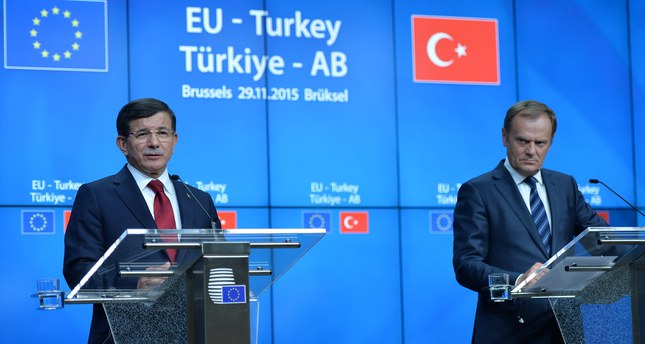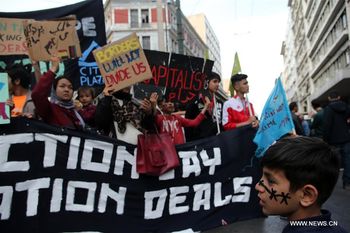The marches in Europe have been inspired by a backdrop of political activism to showcase public support for refugees in a time where they are denigrated in the media and in right wing circles of government. The Refugee Solidarity march has been going on yearly to commemorate the International Day of the Elimination of Racial Discrimination and the need for European countries to incorporate the same sentiments that symbolized this day into how they treat refugees in Europe. Yearly, there have been similar marches across Europe showing solidarity with refugees and combating the rising anti-refugee sentiment that is gripping Europe. The protests were inspired by the same acts of resistance that inspired the Arab spring and the various revolutions across the Arabian world that deposed human rights abusing regimes. The protests have historically existed outside of governmental support and actively try to retain their outsider status to ensure that governments are held accountable for their commitments to refugees and so that the movement does not have to compromise on their beliefs that governments should do as much as they can to help refugees.
Over the past few years, the movement has taken on a large political context by also incorporating the fight for the no borders and the reduction of migrant controls across Europe. This has reignited the No Border movement who have found natural allies in the Refugee Solidarity Movement and thus by combining forces they have been able to increase their lobbying and activist power to potentially influence governments approaches to refugees. The solidarity movement has its base in left leaning, liberal activists who firmly believe that EU governments should do more to help refugees and that International conventions dictate that refugees should be given asylum status and empowered to be active citizens of their countries. With the addition of the No Border movement and anarchist frameworks like the ones being employed at City Plaza Hotel, the Refugee solidarity movement has found prosperity in the left leaning activists in Europe. It has also incorporated a lot of these frameworks in the goals of their movement and action projects in order to encourage more radical notions of refugee support such as taking over unused private property and transforming it into solidarity spaces for refugees and mandating a strict quota on the number of refugees that various EU nations have to take.
Another political message of the march has been its rejection of the EU-Turkey deal which was signed two years ago during the same month. The EU-Turkey deal violates refugees’ rights and allows the European Union to deport those who travel to Greece in favor of taking a low amount of Syrian refugees straight from Turkey. Refugee solidarity activists wholly disagree with the premise of the EU-Turkey deal as it allows EU countries to disregard their legal obligation to protect refugees in Turkey and those stranded across Europe’s closed borders. By taking on political opposition to this deal, it has moved refugee solidarity activists into the political arena and has formalized their opposition to the EU’s political response to the Refugee crisis.

There have been a number of positive commitments and responses to the widespread protests that stook place across European cities calling for various governments to take in more refugees. One of these positive responses has occurred in Spain where some 160,000 thousand Spanish activists marched through central Barcelona to the Mediterranean coast encouraging the Spanish government to take in more refugees. The protest focused on holding the Spanish government accountable to the 17,000 refugees it had promised to take in. The Spanish government had promised to take in 17,000 refugees in 2015 and up till the end of 2017 it had only taken in 1,100. The protest got the attention of local politicians including the Mayor of Barcelona, Ada Colau, who had been at the march and at the forefront of the campaign to get the Spanish government to take in more refugees and stick to its original commitment of taking in 17,000 refugees.

There has also been an outpouring of support from members of the public, activists and government officials who all believe that European countries should do more to take in refugees. When Denmark said it had already taken its fair share of refugees in, with over 17,000 resettled in the country, more than 40,000 people protested outside the Danish parliament building in Copenhagen urging the Danish government to do more and not succumb to the power of anti-refugee sentiment in Europe. Although, the Danish government did not change its stance on the amount of refugees it would resettle this year, it promised to increase that number to 20,000 in the next few years and continue its commitment to being a safe place for refugees to arrive.

Although the marches have brought out hundreds of thousands of people onto the streets of various European Union cities, there has been slow progress with many countries still refusing to host refugees and not agreeing to the EU's quota of refugee intake. Countries such as Austria, Slovakia and Hungary have reintroduced border controls and check to prevent economic and political refugees from entering their countries, Even with the outpouring of support and solidarity with refugees, European governments are not aiming to take in more refugees and provide them with more services but rather further increase border management strategies and prevent refugees from migrating further into Europe.
Moreover, one of the outcomes in the aftermath of the Refugee Solidarity protests was actually the physical showcase of tensions across European cities between refugee supporting activists and those who oppose any quota of refugee intake in their countries. One of the places where tensions have boiled up onto the surface has been in Lesbos, Greece where tensions between Greeks and refugees boiled to the surface with Greek citizens and far right supporters verbally and physically attacking protestors. The attacks in Lesbos against refugees was in response to a group of 200 Afghanis who had camped out for several days in a central square of Mytilene, the main city of Lesbos, to protest against the atrocious conditions that refugees had been subjected to in Lesbos and the travel restrictions that are imposed on them. Instead of the goals of showcasing solidarity with refugees and encouraging governments to take in more refugees, weeks after protestors marched on Mytilene in solidarity with refugees, the same square was full of anti-refugee advocates throwing flares, firecrackers and stones onto refugees, chanting that they "should be burned alive." The goals of the refugee solidarity movement are being promoted in a time of intense opposition to refugees and migrants in Europe. With numerous countries closing down borders and actively refusing to take in refugees by promoting right wing Islamophobic sentiment, the outcomes of the refugee solidarity movement are being directly challenged by the rising anti-refugee sentiment in Europe but also by the increasing support of far-right political groups in Europe who are gaining rising popularity by ostracizing refugees and portraying them as threats to the national security of EU nations.


Watch the video below for a live account of the above attacks on refugees in Lesbos, Greece.
The outcomes of the march so have far have been limited. Not only has it only a month or so since the actions took place, the solidarity movement and protest is facing intense opposition with national governments seeming to introduce policies that are contrary to the goals d the movement in acts of desperation to solve the refugee crisis and show the public that they are making strides in fixing the refugee crisis.
One of the most important outcomes of the Refugee Solidarity has been to showcase the incredibly difficult conditions that refugees live in across Europe. The protests have had impacts outside the traditional scope of government influence with the main priority of the refugee solidarity protests to reignite the conversation on refugee protection in Europe and how after a number of years, European countries are still not prepared or willing to accept refugees into their domestic societies. The protests raised questions as to why refugees are not being protected by European countries and why their human rights are being ignored by European countries. Moreover, the protesters received a lot of Media attention with many news outlets covering the marches that happened across Europe and posing the questions and concerns proposed by the activists and refugees to a wider audience.

Furthermore, the outcome of the march reignited a challenge to the increasing dominance of right wing governments and rhetoric towards refugees. Across Europe, numerous right wing governments have been established that seek to ban refugees from entering their country or reducing their intake of refugees to the lowest amount possible under regulations. Throughout the protests, information was spread on various European countries acceptance quotas of refugees with many countries refusing to take even a hundred refugees. The outcome of the protest was to highlight the lack of involvement of certain countries in providing support for refugees and encouraged ordinary citizens to lobby their governments to support the integration of a larger number of refugees into their country. The protests created alternative knowledge outcomes to the dominant negative narrative of refugees from newspapers such as the Daily Mail who speak about Europe's invasion of dangerous refugees.

